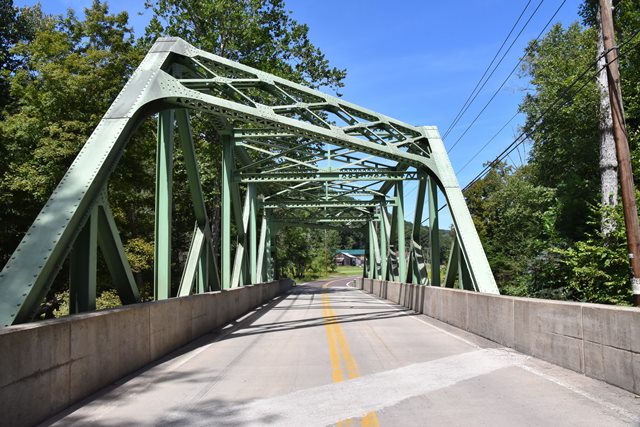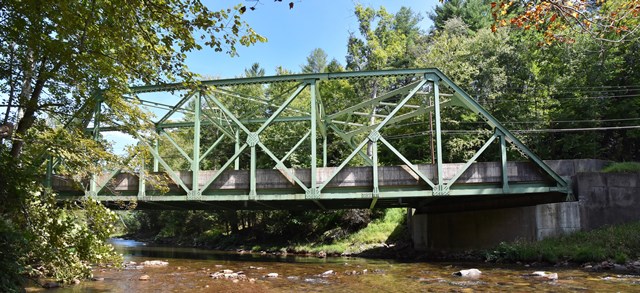We Recommend:
Bach Steel - Experts at historic truss bridge restoration.
BridgeHunter.com Phase 1 is released to the public! - Visit Now
Camp Lavigne Road Bridge

Primary Photographer(s): Nathan Holth
Bridge Documented: August 26, 2019
Rural: Columbia County, Pennsylvania: United States
2006
133.0 Feet (40.5 Meters)
138.0 Feet (42.1 Meters)
23 Feet (7.01 Meters)
1 Main Span(s)
12754

View Information About HSR Ratings
Bridge Documentation
This skewed bridge is one of a very small number of state design through truss bridges to use a Baltimore truss configuration. The bridge has a heavy 45 degree skew, adding to its significance. The finding of this bridge as non-historic by the Historic Bridge Inventory shows a complete lack of understanding of the context of metal truss bridges in Pennsylvania. This bridge is a rare variation of standard state truss design. The department almost always used Parker and Pratt trusses in its standards, a Baltimore truss was rarely used. The bridge was thus significant as an example of the diverse design abilites of the state highway department. In other states, inventories would have found this bridge to be National Register Eligible. The demolition of one of the only other known examples of this design makes this bridge one of the last surviving examples.
View Archived National Bridge Inventory Report - Has Additional Details and Evaluation

Information and Findings From Pennsylvania's Historic Bridge InventoryDiscussion of Bridge The 1934, one span, 139'-long, Baltimore thru truss bridge was built on an extreme skew, which may contribute in part to the decision to use a truss design with subdivided and thus shorter panels resulting in reduced stresses in the floorbeams and stringers (hence smaller sections) and better distribution of loads into the trusses. The use of rolled I section for the verticals, struts, and diagonals is not noteworthy as the detail was common after 1930. The bridge is supported on concrete abutments with flared wingwalls. The chords and end posts are built up box sections, and rolled floorbeams and stringers support the concrete deck. The original lattice railings are still attached inside the truss lines. The use of the truss design with subdivided panels in 1934 is not technologically or historically significant, and neither the bridge nor its setting are historically or technologically significant. Discussion of Surrounding Area The bridge carries a 2 lane state highway over a stream in a sparsely developed area. There are woods beyond the NE quadrant and a field in the flood plain at the NW quadrant. There is a modern house beyond the SE quadrant and field and woods beyond the SW quadrant. Well beyond the south side is a mid-19th century farm house that represents a regional architectural style. Bridge Considered Historic By Survey: Yes |
![]()
Photo Galleries and Videos: Camp Lavigne Road Bridge
Bridge Photo-Documentation
Original / Full Size PhotosA collection of overview and detail photos. This gallery offers photos in the highest available resolution and file size in a touch-friendly popup viewer.
Alternatively, Browse Without Using Viewer
![]()
Bridge Photo-Documentation
Mobile Optimized PhotosA collection of overview and detail photos. This gallery features data-friendly, fast-loading photos in a touch-friendly popup viewer.
Alternatively, Browse Without Using Viewer
![]()
Maps and Links: Camp Lavigne Road Bridge
Coordinates (Latitude, Longitude):
Search For Additional Bridge Listings:
Bridgehunter.com: View listed bridges within 0.5 miles (0.8 kilometers) of this bridge.
Bridgehunter.com: View listed bridges within 10 miles (16 kilometers) of this bridge.
Additional Maps:
Google Streetview (If Available)
GeoHack (Additional Links and Coordinates)
Apple Maps (Via DuckDuckGo Search)
Apple Maps (Apple devices only)
Android: Open Location In Your Map or GPS App
Flickr Gallery (Find Nearby Photos)
Wikimedia Commons (Find Nearby Photos)
Directions Via Sygic For Android
Directions Via Sygic For iOS and Android Dolphin Browser
USGS National Map (United States Only)
Historical USGS Topo Maps (United States Only)
Historic Aerials (United States Only)
CalTopo Maps (United States Only)

